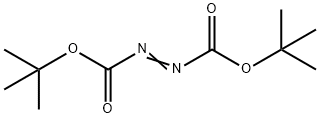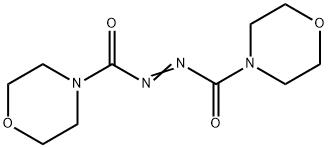Di-tert-Butyl azodicarboxylate
Synonym(s):Bis(1,1-dimethylethyl)azodicarboxylate;DBAD;Di-tert-butyl azodiformate;NSC 109889
- CAS NO.:870-50-8
- Empirical Formula: C10H18N2O4
- Molecular Weight: 230.26
- MDL number: MFCD00015001
- EINECS: 212-796-9
- SAFETY DATA SHEET (SDS)
- Update Date: 2025-10-23 17:31:13

What is Di-tert-Butyl azodicarboxylate?
Description
Di-tert-butyl azodicarboxylate (DtBAD) is a common reagent used in Mitsunobu reactions. Similar azodicarboxyates include DEAD and DIAD. Azo-type reagents such as ADDP are also used for Mitsunobu reactions.
Chemical properties
yellow crystals or crystalline powder
The Uses of Di-tert-Butyl azodicarboxylate
Di-tert-butyl azodicarboxylate is a reagent used in the preparation of acyl hydrazinedicarboxylates. It is also used in the electrophilic amination of beta-keto esters catalyzed by an axially chiral guanidine. It serves as a precursor in an enantioselective synthesis of 3,6-dihyropyridazines employing organocatalysts such as L-proline or (S)-2-pyrrolidinyl tetrazole. It is also utilized in the asymmetric Friedel-Crafts amination through a chiral organocatalyst. Further, it acts as a reactant for preparation of hexapeptide key fragments through stereo selective selenocyclization/oxidative deselenylation reactions. In addition to this, it is employed as a starting material in the synthesis of pyrroloisoquinoline template through stereoselective N-acyliminium-mediated cyclization and enolate amination for preparation of peptidomimetic compounds and Barbier-type propargylation reactions.
The Uses of Di-tert-Butyl azodicarboxylate

To a solution of A (400 mg, 1.54 mmol), B (621 mg, 3.09 mmol), and PPh3 (610 mg, 2.32 mmol) in THF (5.5 mL) at RT was added DEAD (404 mg, 2.32 mmol) in THF (0.5 mL). After 90 min, silica gel was added and the mixture was concentrated and purified on a flash column (25% EtOAc/hexane) to provide the product. [545 mg, 80%]
The Uses of Di-tert-Butyl azodicarboxylate
Utilized in the asymmetric Friedel-Crafts amination via a chiral organocatalyst.
What are the applications of Application
Di-tert-butyl azodicarboxylate is a reagent used in the electrophilic amination
General Description
Di-tert-butyl azodicarboxylate is a an acid labile reagent for Mitsunobu reactions allowing facile isolation of products and for the electrophilic amination and hydrazination of enolates and lithium alkyls.
Purification Methods
The tert-butyl ester has the advantage over the ethyl ester (below) in being a solid and more acid labile. It crystallises from ligroin and is best purified by covering the dry solid (22g) with pet ether (b 30-60o, 35-40 mL) heating to boiling and adding ligroin (b 60-90o) until the solid dissolves. On cooling, large lemon yellow crystals of the ester separate (~ 20g), m 90.7-92o. Evaporation of the filtrate gives a further crop of crystals [Carpino & Crowley Org Synth 44 18 1964]. This reagent is useful in the Mitsunobu reaction [Mitsunobu Synthesis 1 1981, Gennari et al. J Am Chem Soc 108 6394 1986, Evans et al. J Am Chem Soc 108 6394 1986, Hughes Org React 42 335 1992, Dodge et al. Org Synth 73 110 1996, Hughes Org Prep Proc Int 28 127 1996, Ferguson & Marcelle J Am Chem Soc 128 4576 2006, see also DEAD and DIAD below].
Properties of Di-tert-Butyl azodicarboxylate
| Melting point: | 89-92 °C(lit.) |
| Boiling point: | 287.1±9.0 °C(Predicted) |
| Density | 1.06±0.1 g/cm3(Predicted) |
| storage temp. | 2-8°C |
| solubility | Chloroform (Sparingly), Methanol (Slightly) |
| form | Crystals or Crystalline Powder |
| color | Yellow |
| Water Solubility | Insoluble |
| Sensitive | Light Sensitive |
| BRN | 1911434 |
| InChI | InChI=1S/C10H18N2O4/c1-9(2,3)15-7(13)11-12-8(14)16-10(4,5)6/h1-6H3 |
| CAS DataBase Reference | 870-50-8(CAS DataBase Reference) |
Safety information for Di-tert-Butyl azodicarboxylate
| Signal word | Danger |
| Pictogram(s) |
 Flame Flammables GHS02  Exclamation Mark Irritant GHS07  Health Hazard GHS08 |
| GHS Hazard Statements |
H225:Flammable liquids H304:Aspiration hazard H315:Skin corrosion/irritation H319:Serious eye damage/eye irritation H320:Serious eye damage/eye irritation H332:Acute toxicity,inhalation H335:Specific target organ toxicity, single exposure;Respiratory tract irritation H336:Specific target organ toxicity,single exposure; Narcotic effects H360:Reproductive toxicity H370:Specific target organ toxicity, single exposure H372:Specific target organ toxicity, repeated exposure H401:Hazardous to the aquatic environment, acute hazard |
| Precautionary Statement Codes |
P201:Obtain special instructions before use. P202:Do not handle until all safety precautions have been read and understood. P210:Keep away from heat/sparks/open flames/hot surfaces. — No smoking. P233:Keep container tightly closed. P240:Ground/bond container and receiving equipment. P260:Do not breathe dust/fume/gas/mist/vapours/spray. P261:Avoid breathing dust/fume/gas/mist/vapours/spray. P264:Wash hands thoroughly after handling. P264:Wash skin thouroughly after handling. P270:Do not eat, drink or smoke when using this product. P271:Use only outdoors or in a well-ventilated area. P273:Avoid release to the environment. P280:Wear protective gloves/protective clothing/eye protection/face protection. P304+P340:IF INHALED: Remove victim to fresh air and Keep at rest in a position comfortable for breathing. P305+P351+P338:IF IN EYES: Rinse cautiously with water for several minutes. Remove contact lenses, if present and easy to do. Continuerinsing. P307+P311:IF exposed: call a POISON CENTER or doctor/physician. P405:Store locked up. P403+P233:Store in a well-ventilated place. Keep container tightly closed. |
Computed Descriptors for Di-tert-Butyl azodicarboxylate
| InChIKey | QKSQWQOAUQFORH-VAWYXSNFSA-N |
| SMILES | N(C(OC(C)(C)C)=O)=NC(OC(C)(C)C)=O |
Di-tert-Butyl azodicarboxylate manufacturer
ASM Organics
New Products
4,4-Difluoropiperidine hydrochloride tert-butyl 9-methoxy-3-azaspiro[5.5]undecane-3-carboxylate Indole Methyl Resin N-Isopropylurea N,N-Dicyclohexylcarbodiimide(DCC) MELDRUMS ACID 5-METHYLISOXAZOLE-4-CARBOXYLIC ACID Magnessium Bis glycinate Zinc ascorbate 1-bromo-2-butyne 2-acetamidophenol 9(10H)-anthracenone Erythrosin B, 4-Piperidinopiperidine 2-((4-morpholinophenylamino) (methylthio) methylene) malononitrile 2,4-dihydroxybenzaldehyde 3-(4-morpholinophenylamino)-5-amino-1H-pyrazole-4-carbonitrile Methyl 2-methylquinoline-6-carboxylate 2,6-dichloro-4-nitropyridine 4-Bromo-2-chlorobenzonitrile 2-(benzylamino)acetic acid hydrochloride 4-(tert-Butoxycarbonylamino)but- 2-ynoic acid 3,4-dihydro-2H-benzo[b][1,4]dioxepine 1-Phenyl-1-cycloprppanecarboxylicacidRelated products of tetrahydrofuran








You may like
-
 di-t-butylazodicarboxylate 99%View Details
di-t-butylazodicarboxylate 99%View Details
870-50-8 -
 Di-tert-butyl azodicarboxylate 98%View Details
Di-tert-butyl azodicarboxylate 98%View Details -
 Di-tertiary butyl Azodicarboxylate 870-50-8 98%View Details
Di-tertiary butyl Azodicarboxylate 870-50-8 98%View Details
870-50-8 -
 Di-tert-butyl azodicarboxylate CAS 870-50-8View Details
Di-tert-butyl azodicarboxylate CAS 870-50-8View Details
870-50-8 -
 Di-tert-butyl Azodicarboxylate (20% in Toluene) CAS 870-50-8View Details
Di-tert-butyl Azodicarboxylate (20% in Toluene) CAS 870-50-8View Details
870-50-8 -
 Di-tert-butyl azodicarboxylate (DBAD) 98% (HPLC) CAS 870-50-8View Details
Di-tert-butyl azodicarboxylate (DBAD) 98% (HPLC) CAS 870-50-8View Details
870-50-8 -
 Di-tert-butyl azodicarboxylate, 98% CAS 870-50-8View Details
Di-tert-butyl azodicarboxylate, 98% CAS 870-50-8View Details
870-50-8 -
 Di-tert-butyl azodicarboxylate CAS 870-50-8View Details
Di-tert-butyl azodicarboxylate CAS 870-50-8View Details
870-50-8
